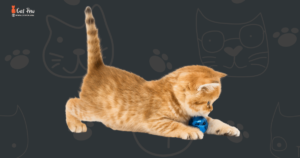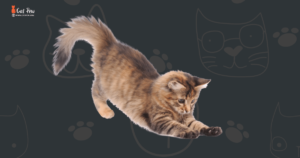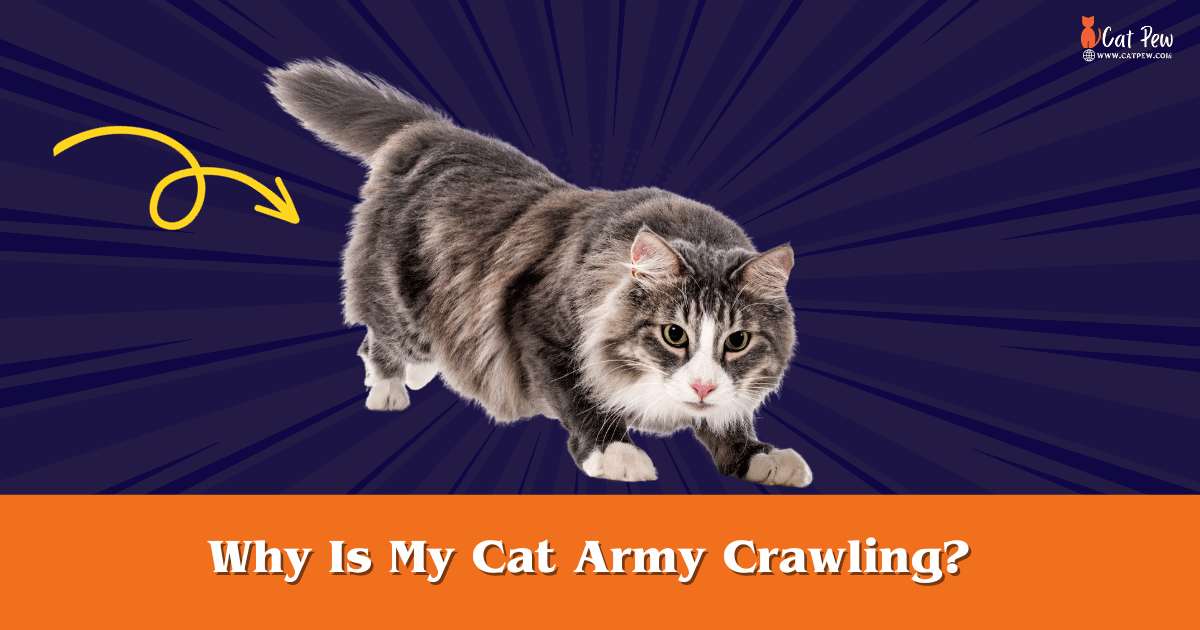Why Is My Cat Army Crawling?
The reason your cat is army crawling is likely due to an instinct for hunting and stalking their prey. Cats often use this low-profile stance to efficiently approach and pounce on their targets.
When cats assume an army crawl position, they prepare to strike and capture their prey.
Understanding Army Crawling: What Is It And Why Do Cats Exhibit This Behavior?

Have you ever noticed your feline friend adopting an intriguing “Army Crawling” behavior? It’s hard to resist a chuckle when your cat dramatically lowers its body, lying flat on the ground, and stealthily moves forward like a soldier on a secret mission. But what exactly is cat army crawling, and why do cats exhibit this behavior? This article will delve into the definition of cat army crawling and explore why your cat may engage in this fascinating behavior.
Definition Of Cat Army Crawling
Cat army crawling, also known as “low crawling” or “belly crawling,” is a peculiar behavior observed in domestic cats. It is characterized by the cat’s tendency to lie flat on its belly and use its front legs to drag the body forward while the hind legs remain stretched out behind it. This unique form of movement resembles the stealthy maneuvering seen in army soldiers, hence the name.
Explanation Of Why Cats Exhibit This Behavior
Curiosity may have killed the cat, but it doesn’t stop them from engaging in intriguing behaviors like army crawling. Here are a few reasons why cats exhibit this peculiar behavior:
- Instinctual Behavior: Despite their domestication, cats retain many hunting instincts from their wild ancestors. Army crawling mimics the stalk-and-pounce technique used by feral cats when hunting prey. Cats can sneak up on their potential prey by imitating this behavior, improving their hunting success rate.
- Playfulness: Cats are renowned for their playful nature. Army crawling can be entertaining for them, allowing them to heighten their senses and engage in mental and physical exercise. It’s common to see cats’ army crawling towards a toy or even your feet during playtime.
- Intimidation and Predatory Stance: Cats may resort to army crawling as a defensive mechanism when faced with a perceived threat or challenge. By positioning themselves low to the ground, they appear smaller and less vulnerable while also adopting a predatory stance to intimidate potential foes.
- Environmental Exploration: Cats are curious creatures who love to explore their surroundings. Army crawling allows them to navigate tight spaces or potentially hazardous areas with caution and curiosity. It will enable them to assess their surroundings stealthily while keeping a low profile.
It’s important to note that while cat army crawling is generally harmless and often amusing, it’s essential to observe your cat’s behavior for any signs of distress or discomfort. If you notice any unusual changes or are concerned about your cat’s well-being, consult a veterinarian to ensure their health and happiness.
The Instinctual Roots: Uncovering The Evolutionary Reasons Behind Army Crawling

Have you ever wondered why your cat engages in that peculiar behavior of army crawling? Observing as their graceful bodies drop to the ground, meticulously inching forward with stealth, is fascinating. To understand this behavior, we must dive deep into the evolutionary instincts of our feline companions. Army crawling in cats manifests their predatory nature, which is directly linked to their hunting behavior.
The Predatory Instincts Of Cats
Cats are natural-born hunters, descendants of the majestic big cats that roamed the wild thousands of years ago. Despite their domestication, they retain many primal instincts, allowing their wild ancestors to survive. These instincts are deeply ingrained in their DNA and play a pivotal role in their army crawling behavior.
When a cat crawls with military precision, it taps into its inner predator. Their heightened senses, flexible bodies, and sharp claws combine to create the perfect hunting machine. Understanding these instincts shows why army crawling is deeply rooted in their evolutionary history.
How Army Crawling Relates To Hunting Behavior
Army crawling is a distinct hunting behavior seen in cats as they silently stalk their prey. Like their wild counterparts, domestic cats utilize every advantage they have when capturing their target. Here’s a closer look at how army crawling relates to their hunting behavior:
- Stealth and camouflage: Cats use army crawling to remain undetected by their prey. They blend into the environment by keeping their bodies low to the ground and moving cautiously. This prevents the mark from noticing their presence and allows cats to get closer without alerting their target.
- Precision and patience: Army crawling involves slow and calculated movements, demonstrating the incredible patience of these feline hunters. Through this behavior, cats carefully plot their approach, aligning every move to ensure they are in the optimal position for a successful attack.
- Enhanced sensory perception: Cats have exceptional hearing and vision, which they utilize to locate and track their prey. Army crawling allows cats to focus intensely on their surroundings, absorbing every movement and sound, enhancing their ability to strategize and anticipate their prey’s next move.
In conclusion, army crawling in cats is an evolutionary manifestation of their predatory instincts. Cats tap into their hunting prowess by carefully maneuvering their bodies close to the ground. With stealth, patience, and enhanced sensory perception, army crawling is a strategic technique to ensure a successful hunt. The next time you catch your feline friend in this captivating behavior, appreciate their ancient connection with their wild ancestors and marvel at the hunting skills within their domesticated exterior.
Physical And Cognitive Factors: Exploring The Factors That Influence Army Crawling In Cats

Explore the physical and cognitive factors contributing to your cat’s unique behavior of army crawling. Uncover why your cat may exhibit this fascinating movement pattern, providing insights into their curious instincts and behaviors.
The Role Of Flexibility And Agility In Army Crawling
Flexibility and agility play vital roles in the army crawling behavior exhibited by cats. As natural-born hunters, cats rely on their ability to navigate through tight spaces and move with agility to catch their prey. Regarding army crawling, flexibility allows cats to contort their bodies and squeeze into narrow openings, while skill enables them to move smoothly and silently.
Cats have a unique skeletal structure that allows for remarkable flexibility. Their supple spines, long and flexible tails, and highly mobile joints enable them to twist, turn, and maneuver effortlessly. Whether sliding under furniture or squeezing through a partially open door, cats use their flexible bodies to army crawl their way into confined spaces.
Furthermore, agility plays a crucial role in a cat’s ability to army crawl. Cats are inherently skilled at maintaining balance and executing precise movements. Their well-developed proprioceptive abilities and exceptional coordination enhance their ability to navigate complex environments. By incorporating subtle adjustments in weight distribution and controlling their limbs with precision, cats can silently army crawl their way toward their target.
The Connection Between Concentration And Army Crawling
Concentration is another significant factor that influences a cat’s army crawling behavior. Army crawling requires high focus and concentration as cats carefully and stealthily progress toward their goal. By reducing distractions and honing their attention, cats can maintain the necessary level of concentration to execute an army crawl successfully.
During an army crawl, cats enter a state of heightened awareness, where their senses become tuned to their surroundings. Their sharp eyesight, acute hearing, and sensitive whiskers combine to detect the slightest movement or sound. Maintaining concentration allows cats to carefully assess their environment, adapt their activities accordingly, and precisely execute the army crawl.
Additionally, concentration during army crawling is essential as cats must constantly adjust their actions based on the environment and potential obstacles. This level of focus ensures that cats can respond quickly and efficiently to any changes in the surrounding space, enabling them to navigate safely and without alerting their prey or potential threats.
Environmental Triggers: Identifying The Situations That Elicit Army Crawling In Cats

One peculiar behavior that cat owners often encounter is when their feline companions suddenly start army crawling. Watching your cat slither on its belly can be pretty amusing, but have you ever wondered why they do it? Understanding the environmental triggers behind army crawling in cats can provide valuable insights into their behavior. Let’s delve into two key factors: exposing cats to new environments and the impact of stress and anxiety.
Exposing Cats To New Environments
When you introduce your cat to a new environment, such as a new home or a temporary stay at a friend’s house, you may notice them resorting to army crawling. This behavior is often their way of adapting and exploring unfamiliar territory. Cats are known for their curious nature, and when faced with new surroundings, they may need to crawl to feel more secure and confident.
Moreover, army crawling serves as a defensive mechanism for cats. By staying low to the ground and moving stealthily, they can assess potential threats while minimizing the chances of being detected. This behavior is deeply rooted in their instincts as natural hunters, enabling them to stay on high alert and ready to pounce if necessary.
The Impact Of Stress And Anxiety On Army Crawling Behavior
Stress and anxiety can significantly affect a cat’s behavior, and army crawling is no exception. Cats are sensitive creatures, and changes in their routine, environment, or even the presence of unfamiliar objects or people can trigger a stress response. Army crawling can be a coping mechanism for cats experiencing anxiety or fear.
When cats feel overwhelmed or threatened, they may use army crawling to reduce their visibility and protect themselves. This behavior allows them to feel more secure and in control, reassuring them during times of heightened stress or anxiety.
Cat owners must be aware of potential stressors in the cat’s environment and take steps to minimize them. By creating a calm and secure environment, you can help alleviate anxiety and reduce the likelihood of army crawling behavior.
By understanding the environmental triggers that elicit army crawling in cats, you can better comprehend and respond to this peculiar behavior. Whether exposing your cat to new environments or addressing stress and anxiety, creating a nurturing environment that promotes comfort and well-being is vital. Stay tuned for our next segment on how to discourage army crawling and encourage positive behaviors in your feline companion.
Dealing With Army Crawling: Tips And Techniques For Managing And Redirecting Cat Behavior

Army crawling, also known as low crawling, is commonly observed in cats. This behavior involves the cat keeping its body down to the ground and moving its front legs forward while dragging its hind legs behind. While this behavior may seem cute or amusing initially, it can sometimes become a nuisance or safety concern, especially if your cat does it at inappropriate times or places. This article will explore some tips and techniques for managing and redirecting cat behavior regarding army crawling.
Creating A Stimulating Environment For Cats
To discourage army crawling behavior in your cat, creating a stimulating and enriching environment that meets their natural needs is essential. Cats are curious creatures that require mental and physical stimulation to stay happy and contented. Here are some ways to create a stimulating environment for your cat:
- Provide plenty of interactive toys that encourage physical activity and mental stimulation. These can include puzzle toys, feather wands, or treat-dispensing toys.
- Designate a play area with climbing structures and scratching posts where your cat can engage in natural behaviors such as climbing, scratching, and jumping.
- Ensure plenty of hiding spots and perches for your cat to explore and observe their surroundings from a safe vantage point.
- Rotate toys and provide new stimuli regularly to prevent boredom and keep your cat engaged.
Training Techniques To Discourage Army Crawling Behavior
While creating a stimulating environment reduces army crawling behavior, it may also be necessary to employ training techniques to discourage this behavior further. Here are some effective methods to try:
- Positive reinforcement: Reward and praise your cat when they display desired behaviors, such as walking instead of army crawling. Use treats or verbal cues to communicate your satisfaction.
- Distract and redirect: When you notice your cat starting to army crawl, gently turn their attention to a more appropriate activity or behavior. Use toys or interactive games to shift their focus.
- Environmental deterrents: Sometimes, using environmental barriers can help discourage army crawling. For example, placing double-sided tape or aluminum foil on surfaces where your cat tends to army crawl can be a deterrent due to its texture.
- Professional advice: If the army crawling behavior persists or becomes a safety concern, seeking guidance from a professional animal behaviorist or veterinarian specializing in feline behavior may be beneficial.
Remember, each cat is unique, and what works for one may not work for another. Consistency, patience, and understanding are essential when dealing with cat behavior. Providing a stimulating environment and employing effective training techniques can help manage and redirect your cat’s army crawling behavior, making for a happier and healthier feline companion.
Frequently Asked Questions Of Why Is My Cat Army Crawling
What Does It Mean When Cats Army Crawl?
Cats army crawl when they move forward with their bellies close to the ground. It’s a hunting behavior often seen when they’re stalking prey or playing. It allows them to maintain a low profile and move stealthily.
Why Is My Cat Doing A Low Crawl?
A low crawl from your cat could indicate a sense of fear, anxiety, or even illness. Observing their behavior and monitoring any changes or accompanying symptoms is crucial. If you’re concerned, consult a veterinarian for a professional assessment and advice.
Why Does My Cat Keep Crawling?
Crawling behavior in cats can be due to various reasons, such as playfulness, curiosity, or exploring their surroundings. Cats’ instinct is to crawl and investigate new areas and objects. If you notice excessive crawling or behavior changes, consult a veterinarian to rule out any underlying health issues.
Why Does My Cat Crawl With A Harness On?
Cats may crawl with a harness because they are uncomfortable or unfamiliar with it. Introducing the harness slowly is essential, making it a positive experience for your cat. Gradually increase the time your cat wears the saddle to help them adjust and feel more comfortable.
Why is my cat crawling on the carpet?
Cats may crawl on the carpet to mark their territory, stretch their muscles, or simply because they find it comfortable.
Why is my cat creeping around the house?
Cats may creep around when they are stalking prey or feeling playful.
Can stress or anxiety cause my cat to crawl excessively?
Yes, stress and anxiety can lead to unusual behaviors in cats, including increased crawling
Is my cat crawling a sign of illness?
Not necessarily, but if your cat’s behavior changes significantly, it’s best to consult a veterinarian.
Conclusion
To conclude, witnessing your cat army crawling can be a perplexing behavior. From seeking attention to exploring new areas, there are various reasons behind this adorable yet curious activity. Understanding your feline’s instincts and behavior can help you provide them with a stimulating and enriching environment.
Remember to offer plenty of playtime, interactive toys, and safe spaces to climb and explore. By embracing their natural tendencies, you can ensure your cat army remains happy, healthy, and entertaining.

Winston
I'm Winston, the author of this feline-focused (Catpew.com) blog . My love for cats goes back to my childhood, when I spent countless hours playing with my family's tabby, Mittens. This furry friend instilled in me a deep appreciation for the unique personalities, playful nature, and unconditional love that cats offer.

